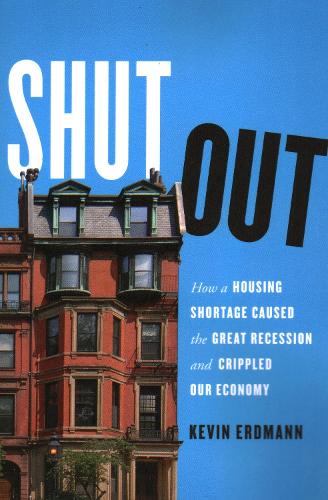
Shut Out: How a Housing Shortage Caused the Great Recession and Crippled Our Economy
(Paperback)
Publishing Details
Shut Out: How a Housing Shortage Caused the Great Recession and Crippled Our Economy
By (Author) Kevin Erdmann
Bloomsbury Publishing PLC
Rowman & Littlefield Publishers
15th September 2021
United States
Classifications
Professional and Scholarly
Non Fiction
Central / national / federal government policies
Society and culture: general
363.50973
Physical Properties
Paperback
322
Width 154mm, Height 229mm, Spine 19mm
513g
Description
The United States suffers from a shortage of well-placed homes. This was true even at the peak of the housing boom in 2005. Using a broad array of evidence on housing inflation, income, migration, homeownership trends, and international comparisons, Shut Out demonstrates that high home prices have been largely caused by the constrained housing supply in a handful of magnet cities leading the new economy.
The same phenomenon is occurring in leading countries across the globe. Gentrifying cities have become exclusionary bastions in the new postindustrial economy. The US housing bubble that peaked in 2005 is more accurately described as a refugee crisis than a credit bubble. Surging demand for limited urban housing triggered a spike of migration away from the magnet cities among households with moderate and lower incomes who could no longer afford to remain, causing a brief contagion of high prices in the cities where the migrants moved.
In this book, author Kevin Erdmann observes that the housing bubble has been broadly and incorrectly attributed to various excesses. Policymakers and economists concluded that our key challenge was that we had built too many homes. This misdiagnosis of the problem, according to Erdmann, led to misguided public polices, which were the primary cause of the subsequent financial crisis. A sort of moral panic about supposed excesses in home lending and construction led to destabilizing monetary and regulatory decisions. As the economy slumped, a sense of fatalism prevented the government from responding appropriately to the worsening situation.
Shut Out provides a much-needed correction to the causes and consequences of financial crises and secular stagnation.
Reviews
Kevin Erdmann has put forward the radical thesis that restrictions on housing supply have been at the center of Americas macroeconomic dilemmas, in addition to raising the cost of living for ordinary Americans. This is one of the few truly new ideas in the debate over the Great Recession. While I still am not sure how much I agree, I find myself thinking about Kevins ideas often, and they grow on my mind. Kevin has poured his heart and soul into making the case in this fascinating new book. -- Tyler Cowen, author, "Stubborn Attachments," and blogger, "Marginal Revolution"
Do you believe that you know what happened during the housing bubble and bust Think again. Kevin Erdmann has amassed a wealth of fascinating data that sheds new light on what actually went wrong with Americas housing market. The basic problem was not too much building or too much lending to low-income people, but rather restrictive housing-development laws pushed people out of closed-access cities on the two coasts and into the contagion cities in Arizona, Nevada, and Florida that were the epicenter of the housing boom. This book sheds important new light on a number of issues beyond housing, including monetary policy, income inequality, and international investment flows. -- Scott Sumner, author, "The Midas Paradox," and blogger, "The Money Illusion"
Kevin Erdmann challenges the most well-known explanations for the housing crash. He argues that the bust, rather than the boom, is the truly exceptional storya result of excessive restrictive credit policy, borne out a lack of understanding of what caused the boom. One neednt agree with his story in full to see that he scores extremely important points and adds a perspective that has been missing from discussions and public policy responses to the housing crash. Fixing supply constraints in rich areas, Erdmann shows, will not only make us richer by allowing people to move to areas where they can get higher wages; it will also make our economy sturdier and less prone to the type of disasters that set back the national and, indeed, the world economy in 200708. -- David Schleicher, Professor of Law, Yale Law School
Even readers convinced by Erdmanns analysis of the housing market may find this inadequate as a narrative of the financial crisis. Nevertheless, that may be too much to expect of one book. Shut Out is still a provocative and illuminating read, which covers far more ground than this review, mostly on the causes and consequences of closed access cities. Erdmann, interestingly, is not a PhD economist, but a former small business owner with a masters in finance. As a member of the PhD tribe, I occasionally found myself wishing for more equations and regression coefficients, and simpler charts. But still, somebody should give him an honorary degree. * Economic Record *
Author Bio
Kevin Erdmann was a small business owner for 17 years. In 2010, he sold his business and earned his masters degree in finance from the University of Arizona, which grounded his real-world experience of investing in the rigor of the academy.
In 2013, he began blogging at idiosyncraticwhisk.com to share his contrarian observations about investment strategies and research. He was surprised to uncover evidence that seemed to contradict conventional narrative and common assumptions about the housing bubble and the financial crisis. As the evidence accumulated, he developed a new account of the causes of the housing bubble and financial crisis. That account eventually became a two-book project, Shut Out and a follow-up book still in development, both of which synthesize and expand on the housing theories he originally published on his blog.
He lives in Gilbert, Arizona, with his wife and three children.
